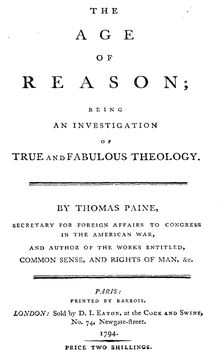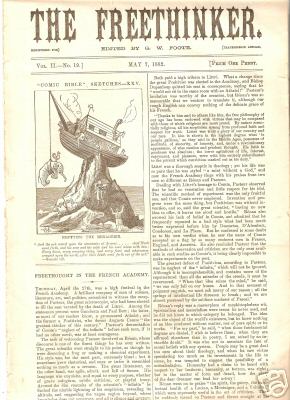A curious characteristic of nineteenth century criminal law was the criminalization of language - so-called word crimes - as seen in the unholy trinity of sedition, blasphemy and obscenity. This might seem counter-intuitive: this was, after all, a period of political liberalization and increased respect for individual liberty. But paradoxically it is precisely this liberalization that lies behind the expansion of the criminal law. On the one hand, increasing political freedom and the relaxation of restrictions around the printing and publishing of books and periodicals led to anxiety about the social impact of 'subversive' speech and writing: what were the servants reading and what effect would it have on them? And on the other, the focus on individual responsibility in the criminal law made it possible to expand criminal regulation to these areas by making the intention of the author central to the question of criminal liability.
While the precise development of each of the three crimes is slightly different, there is a clear pattern. They are all old offences, which were of little practical importance until the late eighteenth and early nineteenth centuries. They were each given new life in response to social and political developments. They were used sporadically throughout the nineteenth century, particularly at moments of political and social unrest and (with the exception of obscenity) fell into a gradual decline. There are also clear structural similarities in the way that the crimes were defined in the modern law.
 |
Tom Paine's The Age of Reason:
Seditious in 1792 |
The origins of the crime of sedition can be traced back to Roman law, where it was understood as a form of violent insurrection that was related to treason. But by the late eighteenth-century it had become the crime of the crime of speaking or publishing words which criticized the sovereign or brought the existing government or laws into contempt. In England the law of seditious libel was used in the wake of the French Revolution to prosecute radicals, such as Thomas Paine who had written books or given speeches arguing for political reform. In Scotland the use of the law was even more draconian, with members of the Society for the Friends of the People convicted for sedition and transported for 14 years. This use of the law was fraught with difficulties as those prosecuted would frequently argue that what they had said or written was not seditious in intent - and juries would occasionally even acquit. So as the immediate political tensions of the 1790s and the Napoleonic Wars passed, the law came to be used in a more limited way. Sedition was still used to prosecute political dissent, but instead of a general focus on the seditious content of the language, definition of the crime came to focus on the potential impact of the language to cause immediate public unrest and the the intention of the speaker or author - whether they knew or ought to have recognized that disturbance was a likely cause of their conduct. The modern crime was thus less about language that might undermine society, but language that might incite unrest. The crime was rarely used in the twentieth century and was abolished in 2009.
 |
The Freethinker
Blasphemous in 1883 |
Blasphemy was likewise an old crime. Its modern origins lie in the separation from the crime of heresy in 1656. While heresy was a crime against God, it was only a crime under ecclesiastical law. Blasphemy, by contrast, was understood as a crime against human law because attacking the christian religion was seen as an attack on those bonds which held civil society together. In this form there had been occasional prosecutions of blasphemous writing in the seventeenth and eighteenth centuries, but the crime was regarded as a minor one, and of little practical importance until the prosecution of the bookseller William Horne in 1817. Although these prosecutions were unsuccessful, this established a patter for the use of the crime in the nineteenth century to prosecute writings of religious dissenters and freethinkers. The core of of the crime was less in the content of the beliefs expressed, than the tendency of the the words - the manner and context in which they were expressed - to undermine society. The last successful prosecution for blasphemy was in 1922 and the crime was abolished in 2008.
Obscene libel was also a crime at common law, but the modern law has its origins in the Obscene Publications Act 1857. This retained the common law definition of obscenity, but for the first time separated sexuality out as an area of special concern and gave the police new powers to seize and destroy obscene material. The test of obscenity laid down in Hicklin (1868) had two central characteristics. First, that the material should have a tendency to deprave and corrupt. This was directed at the effects on the individual, not necessarily as matter of literally depraving or causing immediate arousal, but of how the text or image as a whole could be interpreted and its longer term perverting effects. It was thus concerned with imagination and interpretation. Second, it was specifically directed at the need to protect those who might be vulnerable to such influences —whether women, children, or (in the notorious formulation) domestic servants. In this version the law has survived to the present day, with the test for obscenity even being reproduced in recent legislation criminalizing extreme pornography.
What do they have in common? The first thing is that the modern offences are directed less at the content of the beliefs than the tendency of the expression of the beliefs to undermine society. In each case it is recognized that it might be legitimate to express those beliefs - political or theological debate, or artistic expression - but that in certain circumstances, with a certain intent, that these forms of expression might be dangerous. It is the
tendency of the beliefs to undermine society that is crucial, rather than their actual impact. In sedition and blasphemy the crime is concerned with the impact on society; in obscenity law it is concerned with thecorrupting impact on the individual. But in each case the structure of the offence is the same. And all are concerned with the imagination: the imagination of the vulnerable reader or listener, who may not be able to resist, as well the ability of the authorities to imagine the worst.










